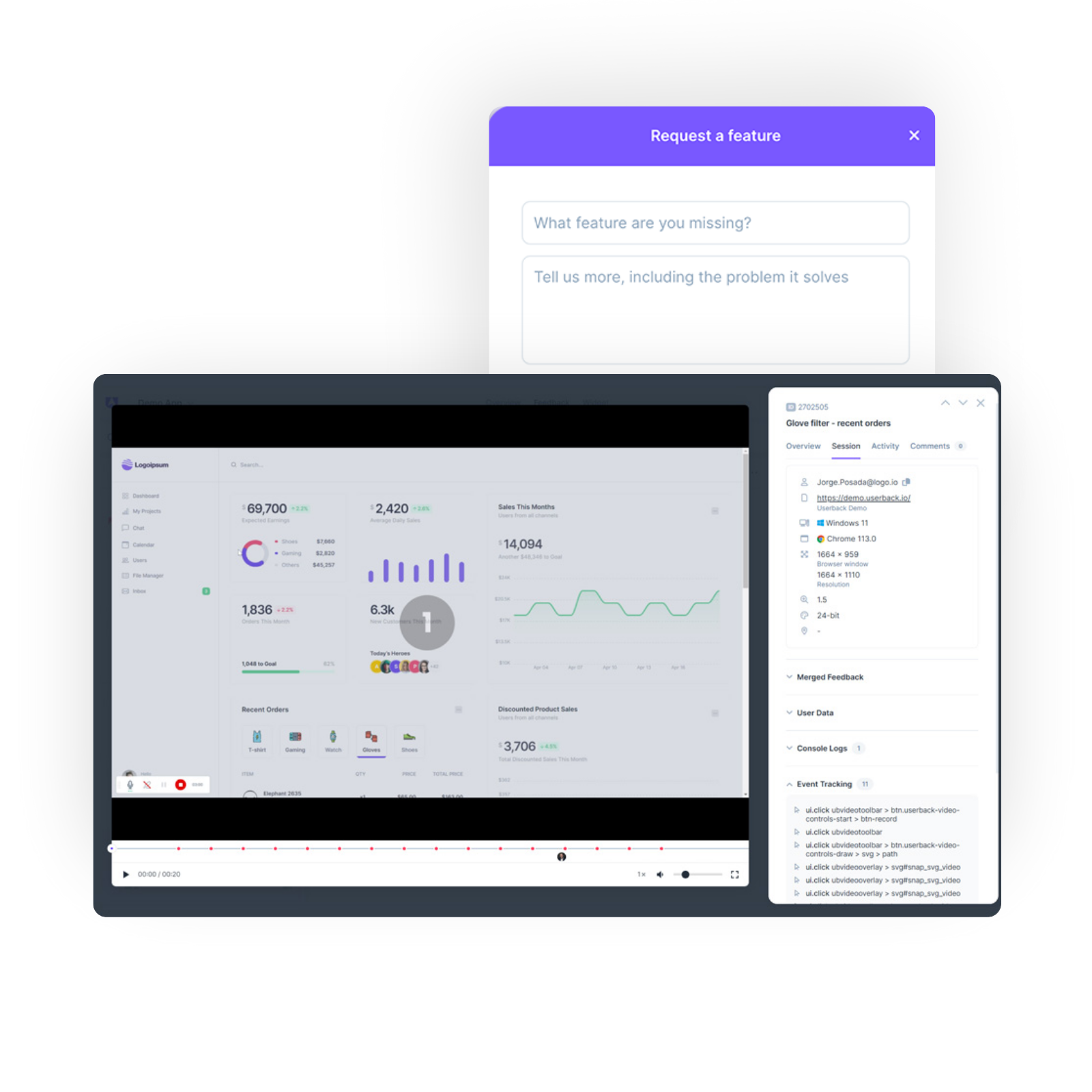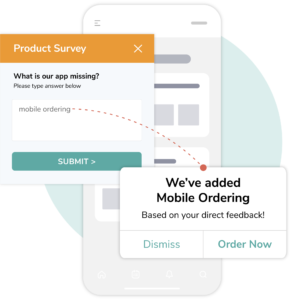
As technology continues to shape the digital landscape, collecting valuable insights from users has become crucial for product managers.
In this article, we take look at the world of in-app feedback, its significance in driving product success and the advantages of a dedicated and centralized in-app feedback platform over traditional methods for managing bug tracking and feature requests. Additionally, we will review five in-app feedback tools to help product managers make informed decisions about the options available to them.
What is In-App Feedback?
In-app feedback refers to the process of collecting user opinions, suggestions, and bug reports within the application itself. By integrating feedback mechanisms seamlessly within software applications, product managers gain direct insights into user experiences and pain points. This real-time product feedback enables rapid iterations, enhances user satisfaction and ultimately improves the overall product quality.
The Importance of In-App Feedback for SaaS and Web Applications
First let’s take a look at why collecting in-app feedback is so important:
01.
Enhanced User Engagement:
In-app feedback facilitates two-way communication between users and product teams, fostering a sense of inclusivity. Users feel valued when their feedback is acknowledged, leading to increased engagement and loyalty.
02.
Improved Product Usability:
Identifying user pain points and areas of confusion helps product managers refine the user interface and streamline workflows. In-app feedback acts as a compass, guiding product teams towards creating intuitive and user-friendly applications.
03.
Bug Detection and Rapid Issue Resolution:
In-app feedback serves as an efficient channel for users to report bugs and technical issues. With real-time access to bug reports, product teams can swiftly address and resolve problems, ensuring a seamless user experience.
04.
Prioritized Feature Development:
In-app feedback allows product managers to understand user needs and preferences, aiding in informed decision-making for future feature development. Gathering insights on user demands helps prioritize features that align with user expectations, increasing customer satisfaction.
05.
Data-Driven Decision Making:
In-app feedback offers a wealth of qualitative and quantitative data, enabling product managers to make data-driven decisions. This eliminates guesswork and ensures that product enhancements are based on user insights rather than assumptions.
06.
Competitive Advantage:
By actively engaging with users and incorporating their feedback, SaaS and web applications can differentiate themselves from competitors. The ability to adapt and listen to users’ needs is key to gaining a competitive edge in the market.
Advantages of a Dedicated and Centralized In-App Feedback Platform
If you’re still using manual processes and tools like spreadsheets and emails to manage you user feedback, then a dedicated in-app feedback tool can save you time and boost efficiency massively:
A.
Streamlined Feedback Collection:
A dedicated platform provides a unified interface for users to share their feedback across different touchpoints within an application. This centralization simplifies the collection process for both users and product teams. By making it easier for users to submit feedback and for product teams to manage it, it allows you to process more feature requests and bug reports in less time, ultimately allowing you to build a better product, faster.
B.
Comprehensive Feedback Analysis:
With a dedicated platform, product managers gain access to advanced analytics and reporting tools. These insights help identify trends, patterns, and prioritize issues based on their impact, ensuring efficient resource allocation.
C.
Customizable Feedback Forms:
In-app feedback platforms offer customizable forms to capture specific information from users. Tailoring feedback forms allows product managers to gather relevant data and reduce noise, resulting in more actionable insights.
D.
Seamless Integration:
Dedicated in-app feedback platforms integrate seamlessly with existing project management and communication tools such as Jira, Slack, ClickUp and many, many more. This integration streamlines the feedback loop and enables effective collaboration between cross-functional teams.
E.
Automation and Workflow Management:
In-app feedback platforms automate processes such as ticket creation, issue tracking, and follow-ups. This automation saves time and ensures that feedback is managed efficiently, leading to faster issue resolution and improved user satisfaction.
6 options for an in-app feedback platform
There are a number of in-app feedback platforms available today. When choosing which in-app feedback platform to use for your SaaS or web application, you need to make sure you choose the one that best meets the needs of your business, team and your users:
01.
Userback
Userback is a user feedback management platform that helps bridge the gap between users and software teams throughout the software delivery lifecycle.
Key in-app feedback features include:
- Visual feedback:
Users can capture screenshots, record videos, and annotate them to provide detailed feedback. - Bug tracking and reporting:
Userback simplifies bug tracking and reporting by allowing users to highlight and comment on specific areas of concern. - Seamless integration:
Userback integrates easily with web applications, allowing users to provide feedback directly within the application. - Collaboration:
Userback facilitates effective collaboration between users, product managers, and development teams. - Customizable feedback forms:
Userback provides the flexibility to create customized feedback forms, capturing specific information from users.
Strengths in collecting and managing in-app feedback:
Userback offers a centralized platform to gather, manage, and prioritize user feedback effectively. Its visual feedback capabilities enable users to provide rich, contextual insights, aiding product improvement.
Userback is a great choice for managing in-app feedback for SaaS applications as it enables seamless integration, streamlines bug reporting, and facilitates collaboration between cross-functional teams.

02.
Instabug
This in-app feedback and bug reporting platform focuses on real-time communication between users and development teams.
Key in-app feedback features include:
- In-app bug reporting:
Users can report issues directly within the application, attaching screenshots and screen recordings for better context. - Crash reporting:
Automatically captures crash logs and provides detailed reports to aid developers in identifying and resolving issues. - In-app surveys:
Allows the creation and deployment of in-app surveys to gather user feedback on specific features or experiences. - SDK integration:
Integrates seamlessly with various platforms and frameworks, ensuring ease of implementation.
Strengths in collecting and managing in-app feedback:
It excels in providing comprehensive bug reporting and crash analysis capabilities, enabling faster issue resolution. It is well-suited for SaaS applications as it offers robust bug reporting features and real-time communication, helping SaaS teams address user concerns promptly.
03.
UserVoice
This customer feedback platform enables businesses to gather and manage user insights effectively.
Key in-app feedback features include:
- Feedback collection:
Users can submit feedback, ideas, and feature requests directly within the application. - Idea prioritization:
Allows users to vote on existing ideas, helping product managers prioritize feature development. - Customer support integration:
Sseamlessly integrates with customer support systems, ensuring efficient management of user inquiries and feedback. - Reporting and analytics:
Provides actionable insights through comprehensive analytics and reporting tools.
Strengths in collecting and managing in-app feedback:
It excels in capturing and prioritizing user ideas, facilitating transparent communication between users and product teams. It empowers product managers to gather customer insights, align feature development with user feedback and enhance overall product satisfaction.
04.
Volley
This visual feedback, website annotation, and bug reporting tool allows users to collect feedback on any website.
Key in-app feedback features include:
- Visual feedback:
Users can create comments directly on webpages, providing visual feedback to highlight specific areas of concern or improvement. - Website annotation:
Allows users to annotate webpages with notes, shapes, and arrows, enhancing the clarity of feedback. - Bug reporting:
Users can easily report bugs and issues they encounter on websites, helping developers identify and resolve them quickly. - Collaboration:
Facilitates collaboration by allowing users to involve team members and stakeholders in the feedback process. - Ease of use:
Offers a user-friendly interface, making it easy for anyone to provide feedback without technical expertise.
Strengths in collecting and managing in-app feedback:
Visual feedback and website annotation features make it easier for users to provide detailed feedback, improving communication between users and development teams.
Simplifies bug reporting by allowing users to highlight and report issues directly on webpages, reducing the time and effort required to explain problems.
Collaboration capabilities enable cross-functional teams to work together, ensuring efficient feedback management and issue resolution.
Streamlines the feedback collection process, enhances collaboration, and enables effective bug reporting. This can help SaaS teams gather valuable insights from users and improve their product based on real-time feedback.
05.
Qualaroo
This user research and feedback platform can help businesses gain qualitative insights into user experiences.
Key in-app feedback features include:
- Feedback surveys:
Allows the creation and deployment of customizable, contextual surveys to gather user feedback. - Behavior-based targeting:
Offers sophisticated targeting options based on user behavior, ensuring relevant survey delivery. - Survey analytics:
Provides detailed analytics and reporting, allowing product managers to derive actionable insights. - Integration capabilities:
Seamlessly integrates with various platforms, enabling easy implementation.
Strengths in collecting and managing in-app feedback:
Specializes in creating personalized and targeted in-app feedback campaigns, providing deep user understanding for product enhancements. The behavioral targeting allows product teams to gather specific feedback from users and make data-driven decisions for SaaS product enhancements.

06.
Marker.io
This in-app feedback and bug reporting tool is designed for agile teams. It allows users to capture and report issues directly within the application.
Key in-app feedback features include:
- Capturing screenshots:
Enables users to capture screenshots of bugs or issues they encounter while using the application. - Annotating images:
Users can annotate the captured screenshots with text, shapes, and arrows to provide additional context and clarity. - Issue tracking:
Tracks and manages reported issues, providing real-time updates on their status and progress. - Integration with project management tools:
Seamlessly integrates with popular project management tools, such as Jira and Trello, to streamline bug reporting and issue tracking workflows. - Collaboration:
Teams can collaborate within the tool, discussing and resolving reported issues effectively.
Strengths in collecting and managing in-app feedback:
Streamlines the bug reporting process by allowing users to capture and annotate screenshots, reducing the effort required to explain issues.
Integration with project management tools ensures seamless tracking and management of reported issues, improving overall productivity.
Collaboration features enable effective communication and efficient issue resolution among team members.
Conclusion
In-app feedback has emerged as an indispensable tool for product managers in the SaaS and web application space. By leveraging dedicated in-app feedback platforms, product teams can unlock valuable insights, improve user experiences, and drive product success.
The availability of leading in-app feedback tools like Userback, Instabug, UserVoice, Apptentive, and Qualaroo empowers product managers to choose the right solution that aligns with their specific needs and objectives.
If you want to experience how Userback can help your organization to streamline and automate in-app feedback collection and management, start your free trial today:
Userback.io/signup
“Love it, use it every day!”
SaaS application and web organizations love Userback! Read more reviews on G2

Power up your feedback loop with The Ultimate Guide to User Feedback for Product Managers
If you are enjoying this article, you might want to download The Ultimate Guide to User Feedback Management. From collection to closure, this comprehensive eBook highlights what you can be doing to streamline your user feedback processes and better understand what your users need in order to deliver the features they want, faster!



